Visiting the Calanques National Park in France – A Complete Guide
The Parc National des Calanques is an area of incredible beauty, diverse landscapes and unique cultural heritage. Located in the South of France, and spanning 20km of coastline between Marseille and Cassis, it’s the only European national park to encompass land, sea and urban areas.
Maybe you’ve already heard of the Calanques de Cassis or Marseille, but you’re not sure where to start with exploring this phenomenal area for yourself…
The aim of this guide is to make your visit to the Calanques National Park less daunting, and more enjoyable.
Read on to find out how to get there, the best hikes and beaches in the Calanques, where to stay, and how to visit the Calanques by boat or car if hiking isn’t suitable for you.

This article may contain affiliate links. See our full disclosure here.
Table of Contents
How to get to the Calanques National Park
There are four main ways to reach the Calanques National Park. You can enter via Cassis, via Les Goudes, near the Luminy University of Marseille, or via Sormiou. I’ll detail each of these options below.
Option 1 – Calanques de Cassis
The most popular way to enter the Calanques park is via the seaside town of Cassis. A stunning destination in itself, Cassis is a historical fishing village surrounded by vineyards, beaches and olive groves.

It’s also the hop-off point for the famous Calanques de Cassis hike which takes in Port Miou, Port Pin, and Calanque d’En Vau.
To get to the Calanques from Cassis, you can walk directly from the village to the first calanque, Port Miou. Or you can drive to Parking de la Presqu’île and start the hike from there.
Option 2 – Les Goudes
The small village of Les Goudes is known as the end of the world, because that’s what it feels like as you leave the bustling city of Marseille behind and drive along the sublime coast to Cap Croisette. But don’t be fooled, because the National Park awaits just around the corner.

Leave your car at the hilltop car park behind the village, or proceed further around the coast to Calanque de Callelongue. Just be aware that parking is limited from that point onwards.
From the Callelongue calanque, you can follow the marked trail to Calanque de Marseilleveyre, Calanque de Queyrons, and Calanque de Podestat.
Option 3 – Luminy University
If you’re planning on hiking to Calanque de Morgiou or Calanque de Sugiton, park at the car park near the Luminy University and follow the marked tracks from the end of Avenue de Luminy.

You can also take the bus to this starting off point for your calanques hike. Simply take the 21 bus towards Luminy at the Castellane bus station on Avenue du Prado.
Do note, that if you’re visiting Morgiou in the winter, you can also drive directly to the calanque from Les Baumettes.
Option 4 – Sormiou
If visiting the Marseille calanques in winter, you can drive directly down to Calanque de Sormiou from the suburb of the same name.

At other times of the year, you’ll need to leave your vehicle in the car park just before the gates, and proceed by foot. One way to get around this restriction though, is to make a booking at Le Chateau – a restaurant within the calanque with a beautiful terrace.
When making your booking, you can give them your license plate number and you’ll be granted access to drive down into the cove.
Best Hikes in the Calanques National Park
There are a lot of hiking trails that crisscross the National Park, some of them merging into one, before splitting off again. Most of the tracks are clearly marked, but it does pay to have an idea of where you’re going before you set out, so you’ll know if you veer off track.

After weaving my way throughout the park over the years, the following trails are my favourites. Obviously for their amazing scenery, but also because they’re doable in a half-day, child (but not necessarily toddler) friendly, and don’t require any specialist skills or equipment!
Hiking the Calanques de Cassis
The most popular day hike in the Calanques National Park, the Calanques de Cassis trail starts nearby Port Miou and continues around the coast to Port Pin.

Port Pin is a beautiful swimming beach, and where many locals go for a summer outing. From here, you can continue up a steep track to the lookout point over Calanque d’En Vau, which is absolutely breathtaking – and one of the most impressive sights in the Calanques National Park (see below).
From this point, you can continue down to the Calanque d’En Vau beach via a steep rocky path, or continue inland to finish the loop track back to Cassis.
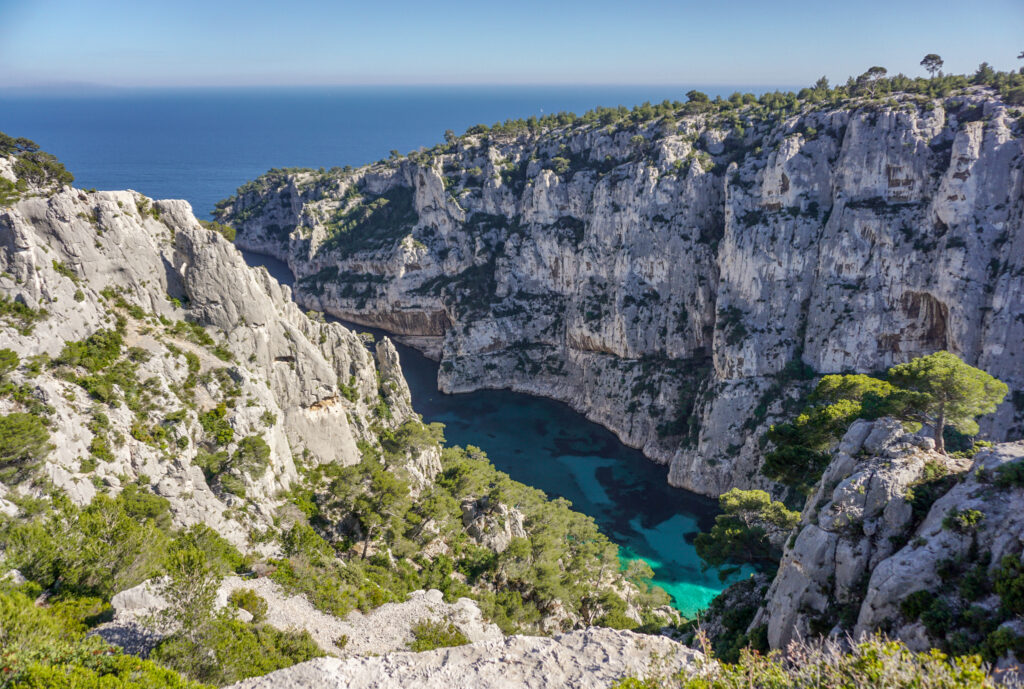
The entire loop takes about 2.5-3 hours to complete at a relaxed pace. Allow around an hour longer to make the descent down to Calanque d’En Vau (and longer if you want to stop for a dip!).
Read more about this hike here: Hiking the Calanques de Cassis; and Hiking to Calanque d’En Vau
Hiking to Calanque de Sugiton
From the car park near Luminy University the track down to Calanque de Sugiton is an absolute joy. Although it starts fairly flat and uneventful, the trees soon clear to reveal an incredible vista.

From the Col de Sugiton, you can venture up to the Belvedere de Sugiton to enjoy the view to its fullest, or bypass this detour and continue straight down to the calanque.
The last leg of the track is a little steep and tricky if travelling with young children, but it’s completely manageable. Once you draw near to the coast, you’ll see Sugiton beach to your left. Unfortunately, it remains cordoned off after a fatal accident occurred involving falling rocks.


Instead, veer right where you’ll find two cozy sheltered bays where you can settle in for a picnic, or find a spare spot to spread out your towel.
The return trek takes around 2.5hrs to complete, plus time to enjoy the beaches at the end. Allow an extra half-hour to venture up to the Belvedere de Sugiton.
Read more about this hike here: Hiking to Calanque de Sugiton
Hiking to Calanque de Marseilleveyre (or Podestat)
From Les Goudes, a wonderful track snakes around the coast starting in Calanque de Callelongue.

Initially heading up behind the village houses, the track then remains fairly level on the cliffs above the sea. This is an easy trek with children in tow and isn’t too long to undertake.
Along the way, you’ll pass by La Mounine – a small inlet without a beach, it makes a popular swimming spot in summer. Then after around an hour, you’ll reach Marseilleveyre.

Calanque de Marseilleveyre is rustic in its appeal and houses a fairly large (by calanque standards) pebbled beach. The shallow, calm water also makes it a fabulous place to swim – especially if travelling with children.
From this calanque, you have the option to loop back to Callelongue via an inland track that takes you up and over the Col de la Galinette. Be ready to climb if you take this route!
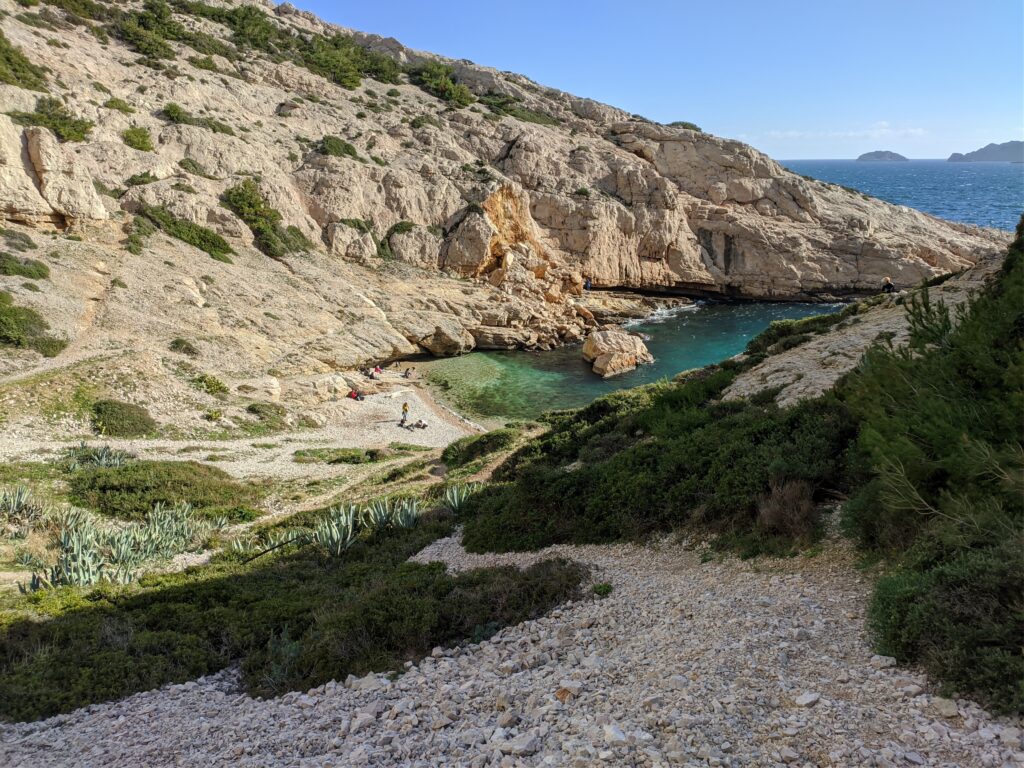
Alternatively, you can return back the way you came, or continue around the coast to the small but beautiful calanques of Les Queyrons and Podestat. Allow around 2.5-3hrs to complete the return trip if you hike to the latter.
Looking for more Provence travel inspiration? Don’t forget to join our free Facebook group Provence Travel Planning!
Best Beaches in the Calanques National Park
The beauty of the calanques beaches is in their remoteness and natural state. Therefore, my favourite beaches are those that are a little harder to get to – but it’s worth the extra effort!
Calanque d’En Vau

The poster child of the Calanques National Park, the beach at Calanque d’En Vau is tucked between towering cliffs that give it the illusion of being a million miles from civilisation.
In reality, you can hike there in around an hour and a half from port Miou (the more strenuous option) or a little longer through the inland route (that doesn’t involve climbing).
There are no facilities at this beach, and it gets busy in summer, but it’ll leave you under no illusion why it’s named as one of the most beautiful beaches in France.
Port Pin

Another contender near Cassis is Port Pin, the second calanque you’ll reach when trekking the Calanques de Cassis. It’s around a 45 minute walk to get there from the aforementioned car park. And involves a slightly steep and rocky descent near the end.
Once you get there, park up on the beach for an afternoon of swimming in a spectacular bay, or wander over the rocks to find a peaceful spot to yourself.
Calanque de Sugiton

Is it any surprise that the best Calanque beaches are found at the end of the best calanque hikes?
Calanque de Sugiton is another of these coincidences. The bay is small but unforgettable. You won’t regret a day well spent swimming around the craggy coastline and snorkelling among the small islands that sit between the two beaches.
Follow the hiking route detailed above to reach this sublime spot.
Plage Sauvage de Morgiou

Calanque de Morgiou isn’t the prettiest calanque, but if you venture away from the fishing port, there are treasures to be found nearby.
Just around the bend, following a rocky trail, you’ll find a small cove tucked away from the bustle of the port. Follow the stairs that have been etched into the limestone cliff to reach the pebbles below.
Due to its petite size, it’s best to get here early to ensure a spot. If however, you arrive later in the day, head further around the coast and you’ll eventually find yourself on a rocky promontory that’s perfect for settling in under the trees. There’s direct access to the sea (although no beach to speak of), so you can dip in when you get too hot.
Calanque de Sormiou
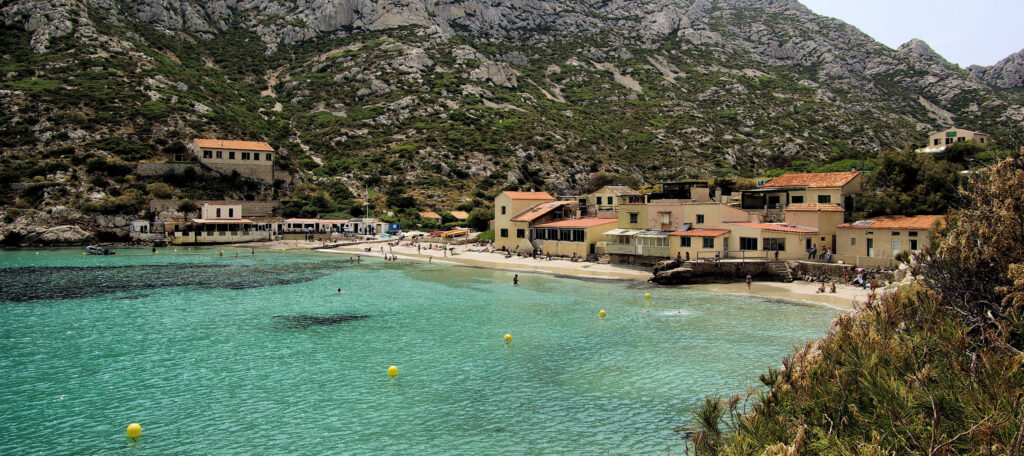
The family-friendly beach at Calanque de Sormiou is a wide sandy beach that’s perfect for water sports and snorkelling. The ideal place to pull out your inflatable kayak or paddle board and explore the coastline.
Unlike the smaller beaches in the calanques national park, there are lifeguards on duty here in the summer.
If you want to venture away from the crowds, you’ll find two smaller coves tucked away to the left-hand side of the main beach, past the small port.
Calanque de Marseilleveyre and Podestat

These two calanques are just 1km apart from each other along the Marseille calanques side of the park.
Marseilleveyre is a larger beach with a few beach huts tucked up behind the pebbled cove. Whereas Podestat is smaller and completely in its natural state.
Both offer a beautiful backdrop, a natural swimming environment, and a quiet retreat (except in the height of summer).
Les Goudes

On the edge of the Calanques National park, near Marseille, Les Goudes is home to several beaches also.
Although more developed than the Calanque beaches featured above, they’re a good option when time is tight, or you fancy a few more luxuries when you’re lounging.
Head along to the Baie des Singes where you’ll find sun loungers available to hire from the seaside restaurant. Or continue down the path to visit the public, sandy beach at the end of the peninsula.
Read more: Best Beaches in Marseille and Surrounds
Visit the Parc National des Calanques by Sea
While it’s not always possible to hike into the calanques due to accessibility issues, weather restrictions (more on this below), or time constraints, there are other options available.

And even if you are planning on undertaking a hike or two, visiting the calanques by boat offers another perspective to appreciate the sheer scale of the fjords.
There are several ways to reach the calanques via the sea, let’s look at the most popular methods below.
Calanques Boat Tour from Cassis
Taking a Cassis calanques boat tour is one of the most popular options for discovering the national park by sea. There are several tours available, and they run all day, every day throughout the summer.
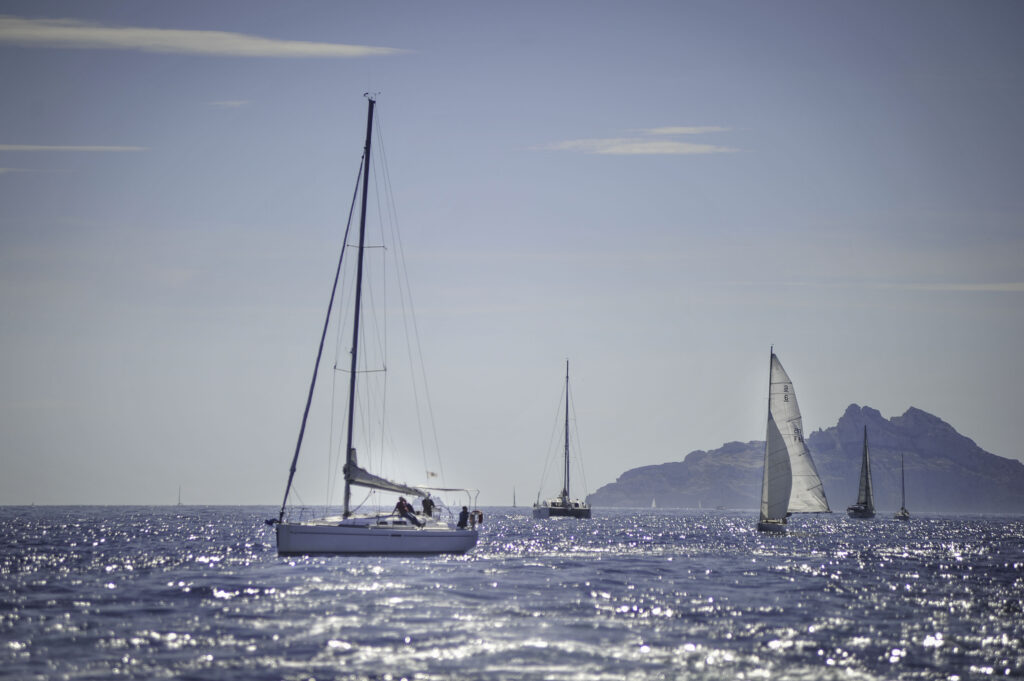
You can simply make your way down to the wooden kiosk at the port in Cassis and choose your desired tour length and departure time.
The downside to this spontaneous approach is that you could have to wait some time to get on a tour on a busy day, and the tours don’t allow for swimming or stopping at the beaches.
If you want a more personalised boat tour of the calanques, you’ll need to book in advance. One company offering boat rentals with a skipper is Bleu Evasion.
Kayak the Calanques de Cassis
Another option, for the more adventurous, is to head out to kayak the calanques – as part of a tour, or self-guided.

If you choose to do it yourself, there are several places in Cassis to hire kayaks from. But keep in mind, that most of them are seasonal.
LOKAYAK and CSLN both allow you to book your kayak online in advance.
If you’d rather go as part of a tour, or with a guide, ExpéNature offers a 6-hour excursion that takes in the Calanques of Cassis. Check it out here.
Calanques Tour from Marseille
If you’re staying in Marseille, a calanques national park boat tour from Marseille might be a better option.

Tours leave directly from the old port, so you can bypass the need to drive anywhere, and enjoy the trip via the sea instead.
I’ve listed some of the more popular calanques boat tours from Marseille below.
Other Activities in the Calanques National Park
Besides hiking, swimming, and sailing, there are plenty of other ways to explore les Calanques National Park.
Mountain Biking in the Calanques National Park
As with hiking, biking is a popular way to discover the beauty of the Calanques National Park. But if you’re not familiar with the terrain, or route, I’d highly recommend joining a guided ride.
Many tour operators offer group rides into the calanques – primarily from Marseille – and provide electric mountain bikes to make the going a little easier. You can find the more popular options below.
Diving in the Calanques National Park
Strap on your snorkel and dive into the clear blue water of the Calanques to discover a vibrant underwater world. The little coves and islands that pepper the coastline are a diver’s delight!
The easiest option is to just jump in the water from Cassis or one of the more accessible calanques and start swimming to discover the marine sanctuary that hides below. But if you want to get out into the deeper waters, or visit the islands further offshore, then joining a guided expedition is the way to go.
Several tours run from Point Rouge in Marseille. Such as this small group 3-hour tour, or this 2-day dive course in the calanques.
Climbing in the Calanques


With its steep ridges, craggy cliffs, and dramatic hills, the Calanques National Park is perfect for climbing!
Experienced climbers won’t having any trouble finding suitable spots, but if you’re new to the sport you can partake too.
Guided tours cater to all levels and will ensure you enjoy yourself while experiencing this unique part of the South of France in a whole new way.
Climbing tours of the Calanques include a half-day option, a full day option; and this initiation course.
Key Things to Know Before Visiting the Calanques National Park
When visiting the Calanques of Marseille or Cassis, it’s important to check the conditions in the National Park ahead of time. The park often closes due to extreme weather – especially in the peak summer months when the wildfire risk is greater. You can check the current on this app.
Other important things to note include:
- Always take enough water and food with you into the park.
- Wear sensible footwear. Technical shoes aren’t needed, but sturdy hiking shoes will help navigate the rocky, and often slippery (even when dry) tracks.
- Take water shoes if you’re planning on swimming. The pebbled beaches can be hard to walk on with bare feet.
- On that note, don’t forget your swimwear and a towel!
- Take sun protection in the form of sunscreen and a hat.
- Wear layers. It’s not uncommon for temperatures to drop as the sun goes down, so take a warm layer for later in the day.
Where to Stay When Visiting les Calanques

The calanques can easily be visited as a day trip from Aix-en-Provence. But if you want to stay a little closer to the action, then Cassis or Marseille are generally the best options.
If choosing to stay in Cassis, I can highly recommend Les Roches Blanches which you can read about here. Alternatively, there are many fabulous Airbnbs within the village. You can see those here.
If Marseille is more your style, you can find our accommodation recommendations in the following articles:
Where to see other Calanques in the South of France
The Parc National des Calanques isn’t the only place to find calanques in the South of France. If you want to experience these natural attractions without venturing into the park, or you simply want to avoid the crowds in summer, there are other places you can go hiking & swimming nearby.
Calanque de Figuerolles, La Ciotat
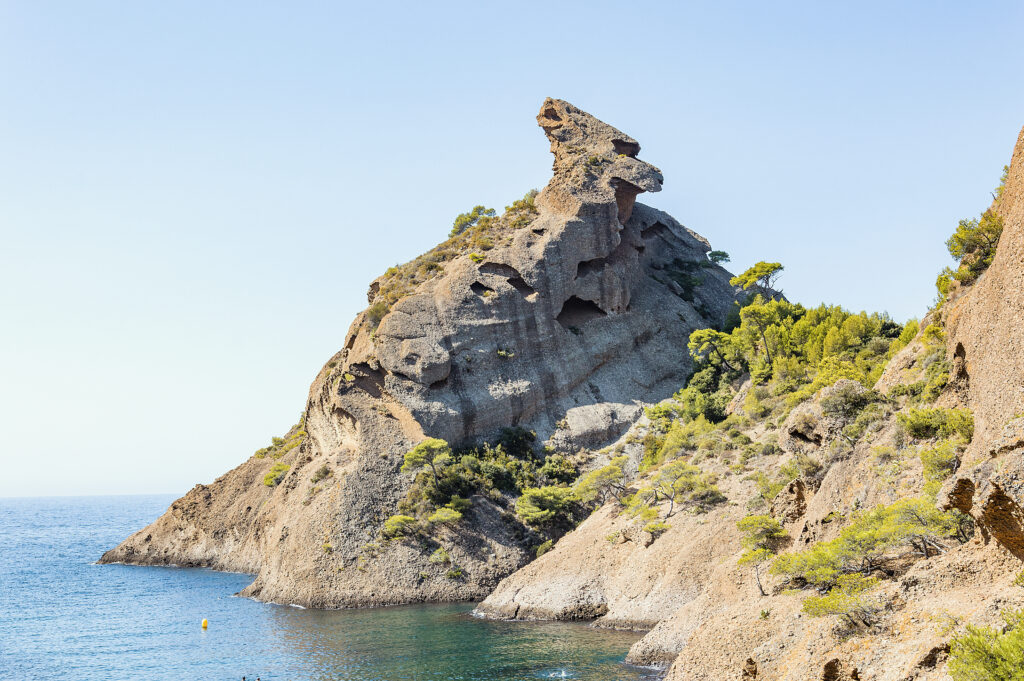
La Ciotat is just around the corner from Cassis and is a bustling small town with a rustic old centre. It’s far less visited that its western neighbour, but there is plenty to see & do.
One of its most beautiful attractions is the Calanque de Figuerolles. Home to a gorgeous beach, it’s perfect for a lazy afternoon swim, as it doesn’t require a hike to get there! There’s also a restaurant on-site, for an after-swim apéro.
Calanque de l’Everine, Niolon

This hidden gem of a beach is located on the lesser-frequented Cote Bleue, to the west of Marseille. And although it’s one of the harder beaches to reach on this stretch of coast, it’s well worth the effort.
You can either take the coastal route from Niolon, or you can park inland and take an easier route down to the beach through fragrant shrubs and forest. Allow around an hour each way, whichever way you choose.
As you’ll see, the Calanques National Park is such an incredible destination, with something to offer everyone. A place of boundless natural beauty and endless ways to enjoy it, it most definitely deserves a spot on your South of France itinerary.
Pin this for later!








Your blog post was extremely helpful; we had a great visit. Thanks so much!